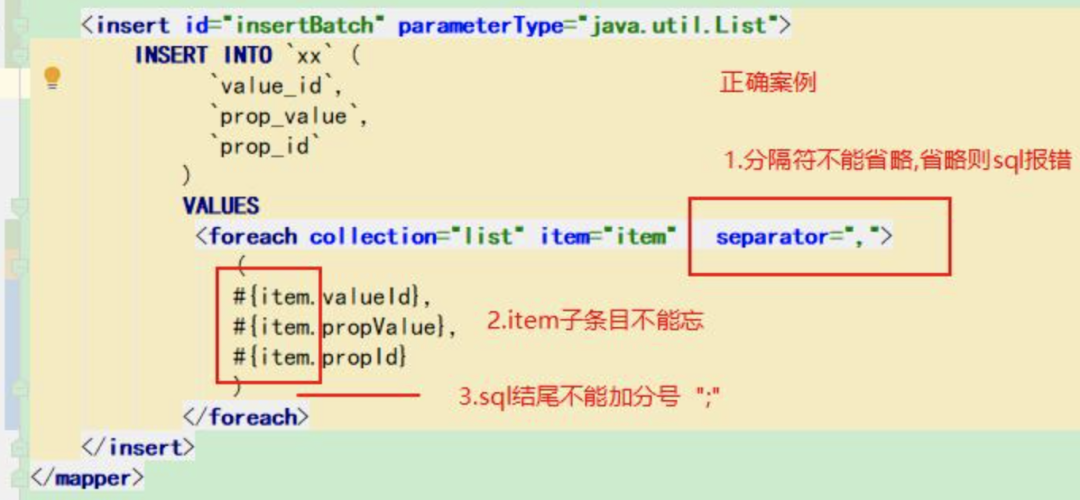MyBatis 三种批量插入方式的比较,我推荐第3个!
你知道的越多,不知道的就越多,业余的像一棵小草!
你来,我们一起精进!你不来,我和你的竞争对手一起精进!
编辑:业余草
jianshu.com/p/cce617be9f9e
推荐:https://www.xttblog.com/?p=5292
Mybatis 批量插入方式的比较
数据库使用的是 sqlserver,JDK 版本 1.8,运行在 SpringBoot 环境下。
对比 3 种可用的方式:
反复执行单条插入语句 xml拼接sql 批处理执行
先说结论:少量插入请使用反复插入单条数据,方便。数量较多请使用批处理方式。(可以考虑以有需求的插入数据量20条左右为界吧,在我的测试和数据库环境下耗时都是百毫秒级的,方便最重要)。「无论何时都不用xml拼接sql的方式」。
代码
「拼接SQL的xml」
newId()是sqlserver生成UUID的函数,与本文内容无关
<insert id="insertByBatch" parameterType="java.util.List">
INSERT INTO tb_item VALUES
<foreach collection="list" item="item" index="index" separator=",">
(newId(),#{item.uniqueCode},#{item.projectId},#{item.name},#{item.type},#{item.packageUnique},
#{item.isPackage},#{item.factoryId},#{item.projectName},#{item.spec},#{item.length},#{item.weight},
#{item.material},#{item.setupPosition},#{item.areaPosition},#{item.bottomHeight},#{item.topHeight},
#{item.serialNumber},#{item.createTime}foreach>
insert>

「Mapper接口」
Mapper
public interface ItemMapper extends Mapper<Item> {
int insertByBatch(List- itemList)
;
}
「Service类」
@Service
public class ItemService {
@Autowired
private ItemMapper itemMapper;
@Autowired
private SqlSessionFactory sqlSessionFactory;
//批处理
@Transactional
public void add(List- itemList)
{
SqlSession session = sqlSessionFactory.openSession(ExecutorType.BATCH,false);
ItemMapper mapper = session.getMapper(ItemMapper.class);
for (int i = 0; i < itemList.size(); i++) {
mapper.insertSelective(itemList.get(i));
if(i%1000==999){//每1000条提交一次防止内存溢出
session.commit();
session.clearCache();
}
}
session.commit();
session.clearCache();
}
//拼接sql
@Transactional
public void add1(List- itemList)
{
itemList.insertByBatch(itemMapper::insertSelective);
}
//循环插入
@Transactional
public void add2(List- itemList)
{
itemList.forEach(itemMapper::insertSelective);
}
}
「测试类」
@RunWith(SpringRunner.class)
@SpringBootTest(webEnvironment = SpringBootTest.WebEnvironment.RANDOM_PORT, classes = ApplicationBoot.class)
public class ItemServiceTest {
@Autowired
ItemService itemService;
private List- itemList = new ArrayList<>();
//生成测试List
@Before
public void createList(){
String json ="{\n" +
" \"areaPosition\": \"TEST\",\n" +
" \"bottomHeight\": 5,\n" +
" \"factoryId\": \"0\",\n" +
" \"length\": 233.233,\n" +
" \"material\": \"Q345B\",\n" +
" \"name\": \"TEST\",\n" +
" \"package\": false,\n" +
" \"packageUnique\": \"45f8a0ba0bf048839df85f32ebe5bb81\",\n" +
" \"projectId\": \"094b5eb5e0384bb1aaa822880a428b6d\",\n" +
" \"projectName\": \"项目_TEST1\",\n" +
" \"serialNumber\": \"1/2\",\n" +
" \"setupPosition\": \"1B柱\",\n" +
" \"spec\": \"200X200X200\",\n" +
" \"topHeight\": 10,\n" +
" \"type\": \"Steel\",\n" +
" \"uniqueCode\": \"12344312\",\n" +
" \"weight\": 100\n" +
" }";
Item test1 = JSON.parseObject(json,Item.class);
test1.setCreateTime(new Date());
for (int i = 0; i < 1000; i++) {//测试会修改此数量
itemList.add(test1);
}
}
//批处理
@Test
@Transactional
public void tesInsert() {
itemService.add(itemList);
}
//拼接字符串
@Test
@Transactional
public void testInsert1(){
itemService.add1(itemList);
}
//循环插入
@Test
@Transactional
public void testInsert2(){
itemService.add2(itemList);
}
}
测试结果:
10条 25条数据插入经多次测试,波动性较大,但基本都在百毫秒级别
| 方式 | 50条 | 100条 | 500条 | 1000条 |
|---|---|---|---|---|
| 批处理 | 159ms | 208ms | 305ms | 432ms |
| xml拼接sql | 208ms | 232ms | 报错 | 报错 |
| 反复单条插入 | 1013ms | 2266ms | 8141ms | 18861ms |
其中 拼接sql方式在插入500条和1000条时报错(似乎是因为sql语句过长,此条跟数据库类型有关,未做其他数据库的测试):com.microsoft.sqlserver.jdbc.SQLServerException: 传入的表格格式数据流(TDS)远程过程调用(RPC)协议流不正确。此 RPC 请求中提供了过多的参数。最多应为 2100
可以发现
循环插入的时间复杂度是 O(n),并且常数C很大 拼接SQL插入的时间复杂度(应该)是 O(logn),但是成功完成次数不多,不确定 批处理的效率的时间复杂度是 O(logn),并且常数C也比较小
结论
「循环插入单条数据」虽然效率极低,但是代码量极少,在使用tk.Mapper的插件情况下,仅需代码,:
@Transactional
public void add1(List- itemList)
{
itemList.forEach(itemMapper::insertSelective);
}
因此,在需求插入数据数量不多的情况下肯定用它了。
「xml拼接sql」是最不推荐的方式,使用时有大段的xml和sql语句要写,很容易出错,工作效率很低。更关键点是,虽然效率尚可,但是真正需要效率的时候你挂了,要你何用?
「批处理执行」是有大数据量插入时推荐的做法,使用起来也比较方便。
评论
